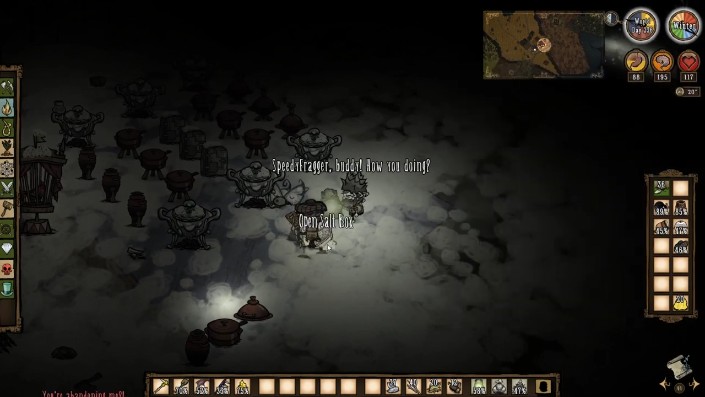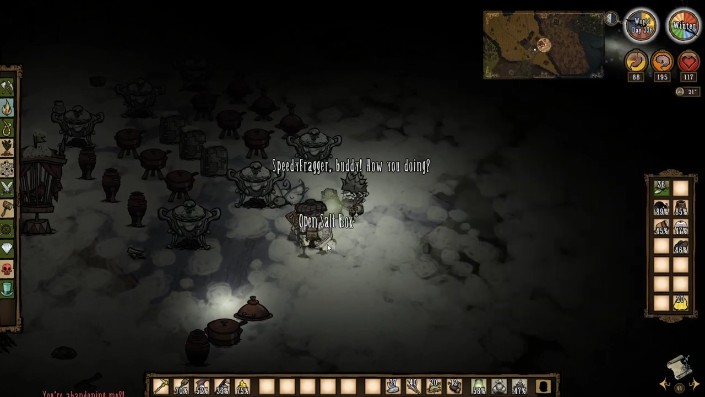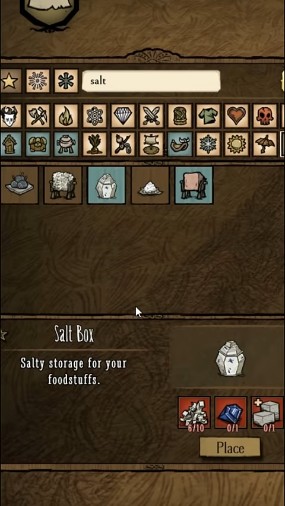In the unforgiving world of Don't Starve Together (DST), survival hinges on effective resource management and strategic planning. One crucial aspect of this is food preservation, which can significantly extend the shelf life of your edible resources. The Salt Box is a powerful tool in this endeavor, offering superior preservation capabilities compared to the more commonly used Ice Box. This guide will delve into the specifics of the DST Salt Box, its crafting requirements, usage benefits, and how it fits into a comprehensive survival strategy.
Understanding the DST Salt Box
The Salt Box is a craftable structure introduced in the Return of Them update for DST. It is designed to store and preserve food items, significantly extending their shelf life. Unlike the Ice Box, which halves the spoilage rate of stored items, the Salt Box reduces spoilage by four times, making it twice as efficient for preserving uncooked foods.
Crafting Requirements
To craft a Salt Box, you will need the following items:
- 10 Salt Crystals
- 1 Blue Gem
- 1 Cut Stone
- An Alchemy Engine to prototype the recipe.

The crafting recipe for the Salt Box, showcasing the required materials.
Usage Benefits
- Extended Shelf Life: The Salt Box preserves food four times longer than the Ice Box, making it ideal for storing raw ingredients.
- Efficient Storage: It can hold up to 9 stacks of food items, though it cannot store cooked food, Crock Pot dishes, seeds, or items without a cooked form like honey or ice.
- Raw Ingredients Only: While it cannot store cooked food, it's perfect for preserving raw meats and vegetables, which can be cooked later as needed.
Strategic Use of the Salt Box in DST
Combining with Other Preservation Methods
- Ice Box: Use for cooked foods or items that cannot be stored in a Salt Box.
- Drying Racks: Dry meats to create jerky, which can be stored indefinitely on the rack or in an Ice Box for extended periods.
- Bundle Wrap: For ultimate preservation, use Bundle Wrap to keep food fresh indefinitely, though this requires defeating the Bee Queen to obtain the necessary materials.

A visual comparison of the Salt Box, Ice Box, and Drying Racks for food preservation.
Optimizing Food Production
- Farming: Set up farms for sustainable food sources like Dragonfruits, Garlic, and Peppers. These crops provide essential ingredients for various recipes.
- Meat Sources: Establish spider farms or pig houses near your base for a steady supply of meat.
- Bee Boxes: Plant flowers around bee boxes to produce honey, which is a versatile ingredient and lasts long when stored properly.
Salt Box in Different Scenarios
- Exploration: When venturing away from your base, use the Salt Box to store raw ingredients that can be cooked later, ensuring a steady food supply.
- Base Management: Keep a Salt Box at your base to store excess raw food, reducing the need for frequent foraging trips.
Real-World Analogies for Understanding DST Survival
In real-world survival scenarios, preserving food is crucial for sustaining life over extended periods. The concept of using salt for preservation dates back centuries, where salt was used to cure meats and extend their shelf life. Similarly, in DST, the Salt Box serves as a digital equivalent, allowing players to "cure" their digital food supplies.
Example: Salted Meats in History
Historically, sailors and travelers used salt to preserve meats during long voyages. This method allowed them to store food for months without refrigeration. In DST, the Salt Box serves a similar purpose, enabling players to store raw meats and vegetables for extended periods, much like how our ancestors preserved food for long journeys.

An illustration of salted meats, highlighting the historical context of food preservation.
Conclusion and Additional Resources
The DST Salt Box is a vital tool for any serious survivalist in Don't Starve Together. By leveraging its superior preservation capabilities, players can maintain a stable food supply, focus on exploration, and tackle the game's challenges with confidence.
Actionable Summary
- Craft a Salt Box early in the game to optimize food storage.
- Combine with other preservation methods like Ice Boxes and Bundle Wrap for maximum efficiency.
- Set up sustainable food sources through farming and animal husbandry.